Proper nutrition ensures Clematis develops strong roots, healthy foliage, abundant flowers, and increased resistance against diseases and pests. It helps promote lush growth while enhancing the plant’s ability to absorb water efficiently. Additionally, fertilizing promotes prolific flowering in Clematis by providing adequate nutrition during critical bud formation and bloom production stages.
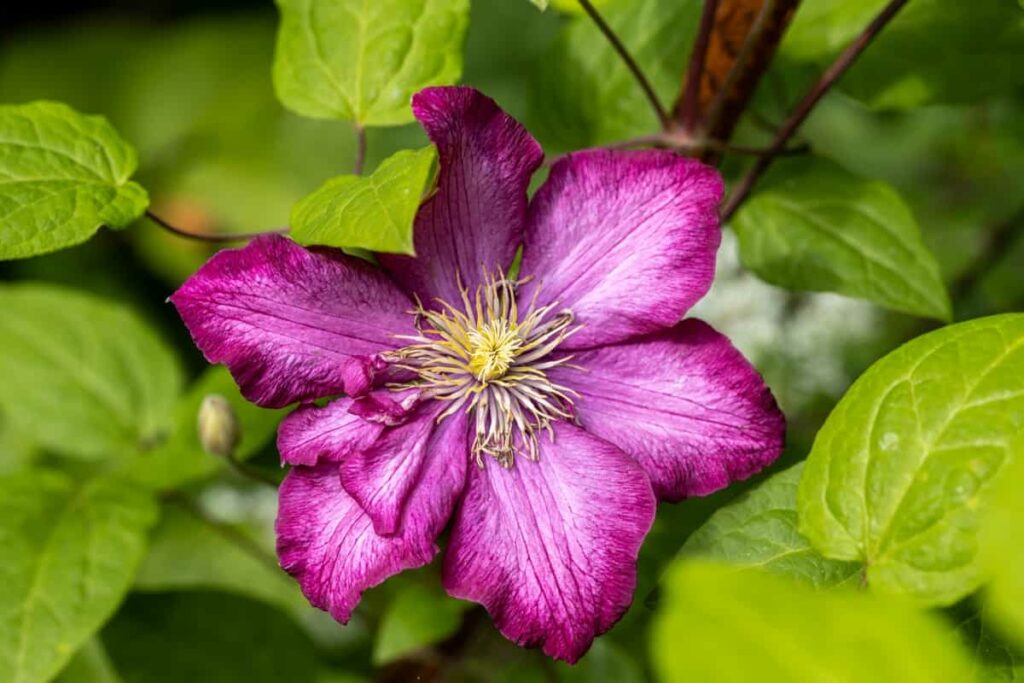
Clematis plants are hungry, thirsty plants. Water the Clematis plant regularly in dry weather and feed it with a high potash fertilizer before it blooms. This is important when growing Clematis in pots. Clematis is a beloved plant among gardeners with its stunning blooms and climbing vines. Understanding its nutritional needs is crucial to ensure it thrives and produces vibrant flowers year after year.
Clematis requires certain essential nutrients to grow and flourish like any living organism. To meet these nutritional requirements successfully, choosing the right fertilizer is paramount. Organic options provide gentle, slow-release nutrients for both plants and the environment. Natural fertilizers derived from sources like compost or manure can also be beneficial.
Best Fertilizer for Clematis
Fertilizer Recommendations for Clematis
| Common Name | Clematis |
| Organic Fertilizers | Compost, Fish emulsion, Seaweed extract |
| Natural Fertilizers | Vermicompost, Bone meal |
| Homemade Fertilizers | Compost Tea, Banana Peel Fertilizer, Epsom Salt Solution, Eggshell Powder |
| Techniques | Top-dressing, Foliar feeding |
| NPK Ratio | Balanced fertilizer – 10-10-10 or a lower nitrogen type like 5-10-5 |
| Best to Apply Fertilizer | Early spring |
Organic Fertilizers for Clematis
Compost – It is rich in organic matter and contains a balanced mix of nutrients slowly released into the soil over time. You can make your compost or purchase it from a reputable source. Another option is well-rotted manure, aged to eliminate any potential weed seeds or pathogens. Manure provides essential nutrients like nitrogen, phosphorus, and potassium while improving soil structure.
Fish Emulsion – It is another effective organic fertilizer for Clematis. It combines ground-up fish with water, creating a nutrient-rich liquid that plants can easily absorb. It is high in nitrogen and contains trace minerals necessary for plant growth.
Seaweed Extract – Seaweed is packed with micronutrients, vitamins, and hormones that stimulate root development and overall plant health. In addition to these options, many other specialized organic fertilizers are available today specifically formulated for flowering plants like Clematis.
Natural Fertilizers for Clematis
Compost – Rich in organic matter and beneficial microorganisms, compost provides slow-release nutrients that promote healthy growth and vibrant blooms. Spread compost around the base of your Clematis plant and gently work it into the soil.
Vermicompost – These nutrient-rich droppings from earthworms contain high nitrogen, phosphorus, potassium, and other elements that stimulate root development and overall plant health. Apply worm castings as a top dressing or mix them into the soil before planting.
Bone meal – It is a good source of phosphorus for Clematis plants. Derived from ground animal bones rich in calcium phosphate compounds, bone meal encourages robust root development and strengthens stems while promoting abundant flower production.
In case you missed it: Best Fertilizer for Bermuda Grass: Best Time to Apply, NPK, Organic, Synthetic, Slow-release, and Quick-release
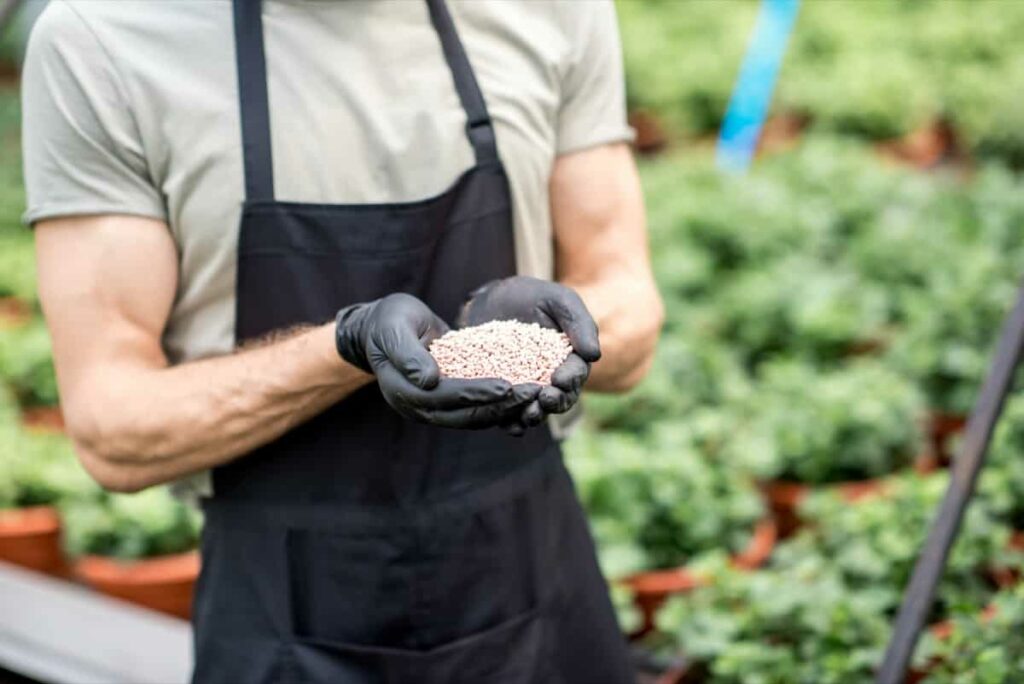
Homemade Fertilizers for Clematis: DIY Recipes
Compost Tea: This is a simple and effective homemade fertilizer for Clematis. To make compost tea, steep compost in water for a few days until it becomes a dark liquid. Dilute the mixture with water and use it to water your Clematis plants.
Banana Peel Fertilizer: Don’t throw away those banana peels. They contain potassium and other essential nutrients that can benefit your Clematis. Bury chopped-up banana peels around the base of the plant or blend them with water to create a nutrient-rich liquid fertilizer.
Epsom Salt Solution: Epsom salt is rich in magnesium sulfate, which helps promote healthy growth in plants like Clematis. Dissolve Epsom salt (1 tablespoon) in 1 gallon of water and apply it to your Clematis every month during the growing season.
Eggshell Powder: Crushed eggshells are an excellent source of calcium carbonate, which can strengthen the cell walls of your Clematis plants and prevent diseases like blossom end rot. Grind dried eggshells into a fine powder and sprinkle around the base of your plant.
The Importance of NPK Ratio in Clematis Fertilizers
The NPK ratio refers to the three main nutrients that plants need: nitrogen (N), phosphorus (P), and potassium (K). Nitrogen is responsible for promoting leafy green growth and overall plant vigor. Too much nitrogen can result in abundant foliage but few flowers. Phosphorus helps with root development, flowering, and fruiting.
It also aids in energy transfer within the plant. Potassium contributes to disease resistance, drought tolerance, and overall plant health. For Clematis, a balanced fertilizer such as 10-10-10 or a lower nitrogen type like 5-10-5 would be ideal. These ratios ensure that your plant receives adequate amounts of each nutrient without overstimulating excessive foliage growth at the expense of blooms.
Finding the right balance is key when selecting fertilizers for your Clematis. Considering the NPK ratio, you can provide your plant with essential nutrients for healthy growth and abundant flowering throughout its growing season. The ideal NPK ratio for Clematis would be a balanced fertilizer like 10-10-10 or a lower nitrogen type like 5-10-5.
Choosing the Best Organic Fertilizer for Clematis
Choosing the best organic fertilizer for your Clematis plants is important for their health and growth. These fertilizers are derived from natural sources, making them a safe and environmentally friendly option. Look for a balanced formula that provides essential macronutrients like N, P, and K. These nutrients promote healthy foliage, robust root development, and vibrant blooms.
Clematis plants require trace elements like iron, manganese, zinc, and copper to thrive. Choosing an organic fertilizer that contains these micronutrients will ensure your Clematis receives all the necessary components for optimal growth. Additionally, it’s worth noting that slow-release organic fertilizers can provide a steady source of nutrients over an extended period. This can be beneficial as it reduces the risk of over-fertilizing or burning your plants.
Consider factors such as ease of application and compatibility with other gardening practices you may have in place. Some organic fertilizers come in liquid form, while others are granular or pelletized. Choose one that suits your preferences and fits your existing gardening routine well.
In case you missed it: Best Fertilizer for Curry Leaves in Pots: Organic, Natural, Homemade, NPK, When and How to Apply
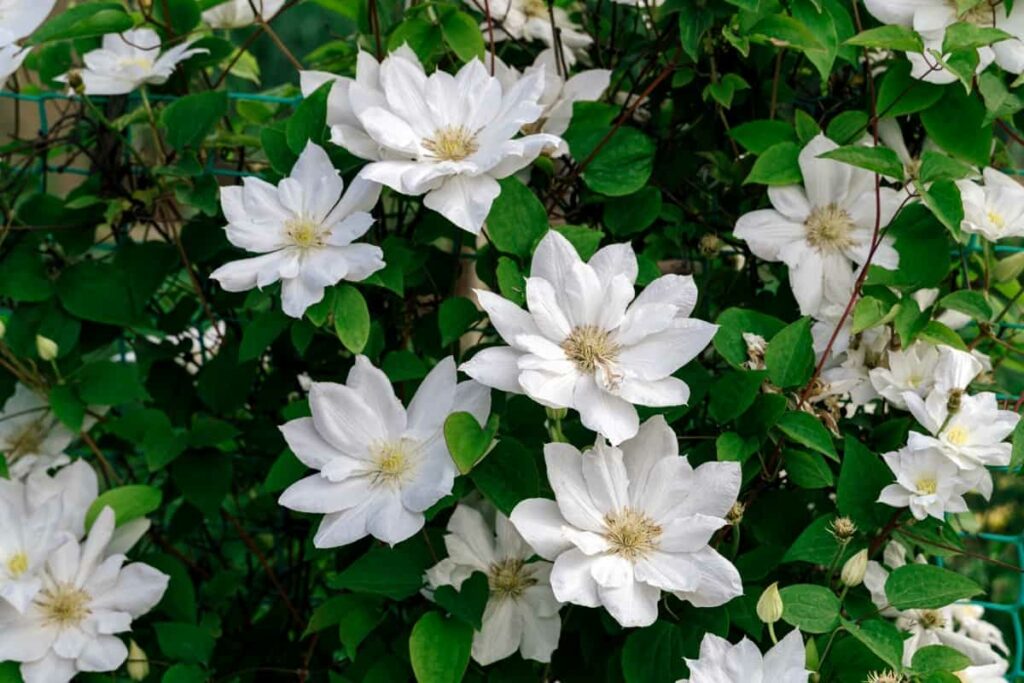
When to Apply Fertilizer to Clematis: Timing is Key
The ideal time to fertilize your Clematis begins in spring and continues through the growing season. This ensures that your Clematis plants have a steady supply of nutrients when needed most. When new growth appears in the spring, it’s time to feed your Clematis. This will help give them a boost of energy after their winter dormancy.
How to Apply Fertilizer to Clematis: Techniques
One technique is known as top-dressing, which involves spreading the fertilizer around the plant base. This allows for the slow release of nutrients over time. Another technique is foliar feeding, where a liquid fertilizer is sprayed directly onto the leaves of the Clematis. This method provides quick absorption of nutrients and can be beneficial during periods of high stress or when rapid growth is desired.
It’s important to remember that Clematis have delicate roots, so care should be taken not to disturb them when applying fertilizer. Avoid digging or cultivating near the base of the plant. In addition, timing is key when it comes to fertilizing your Clematis. It’s best to apply fertilizer in early spring as new growth emerges and continue lightly throughout the growing season. This ensures that your Clematis receives a steady supply of nutrients without overwhelming its system.
The Role of Nitrogen in Clematis Fertilization
Nitrogen plays a crucial role in Clematis plants’ overall growth and development. As an essential nutrient, it promotes vigorous foliage, lush green leaves, and strong stems. This vital element helps to stimulate chlorophyll production, which aids in photosynthesis and enhances the plant’s ability to convert sunlight into energy. It’s important to strike a balance when it comes to nitrogen fertilization.
To ensure optimal nitrogen levels for your Clematis, consider using organic fertilizers that gradually release nutrients. Slow-release formulations provide a steady nitrogen supply without overwhelming the plant with excess amounts. Additionally, incorporating compost or well-rotted manure into the soil can help improve its fertility and naturally increase nitrogen levels.
Regularly monitoring your Clematis plants for signs of nutrient deficiency or excess is key to maintaining proper nutrition balance. If you notice yellowing leaves or weak growth, it may indicate that your Clematis needs more nitrogen-rich fertilizer. However, reducing nitrogen inputs might be necessary if you observe excessive leafy growth but few blooms forming.
Phosphorus and Clematis Fertilization
Phosphorus plays a vital role in the fertilization of Clematis plants. It is an essential nutrient that promotes strong root development, improves flowering, and enhances overall plant health. When it comes to Clematis fertilization, ensuring an adequate phosphorus supply is crucial. Phosphorus helps Clematis plants convert other nutrients into usable forms, aids energy transfer within the plant cells, and stimulates flower production.
In case you missed it: Unlocking the Secrets of Optimal Fertilizer Requirements for Potato Crop
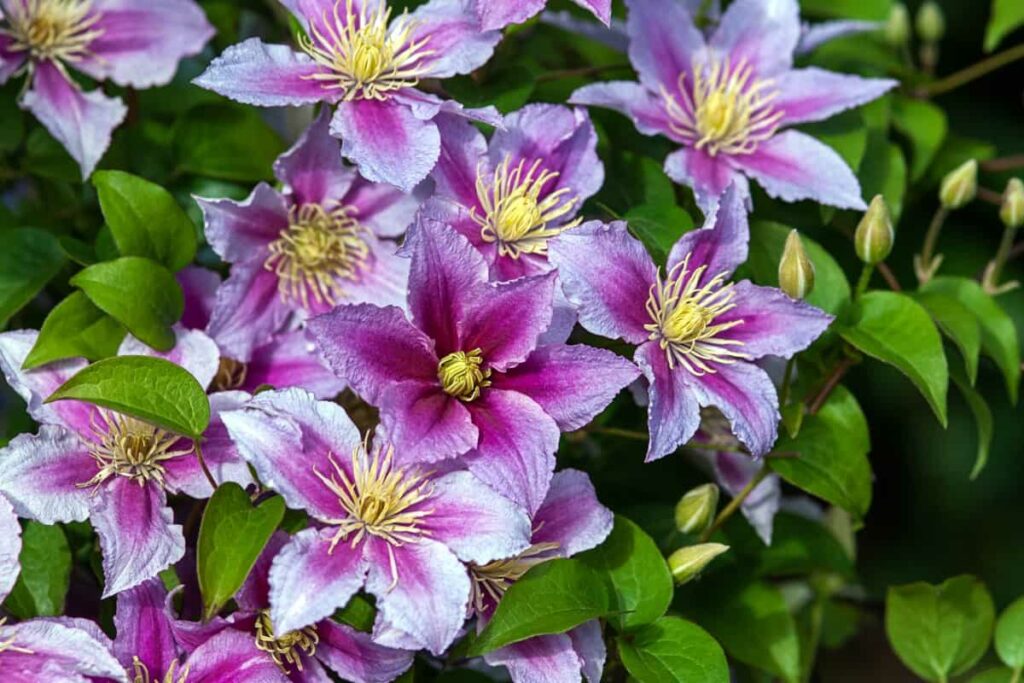
Without sufficient phosphorus, your Clematis may struggle to bloom or produce weak flowers. Consider using organic sources of phosphorous, such as bone meal or rock phosphate, if you prefer natural alternatives. These products release their nutrients over time and are gentle on the environment.
Potassium and Clematis Fertilization
Potassium is an essential nutrient for Clematis plants, crucial to their health and development. It contributes to strong root growth, improved disease resistance, and enhanced flower production. By ensuring that your Clematis receives an adequate supply of potassium, you can enjoy vibrant blooms and vigorous growth. One benefit of potassium in Clematis fertilization is its ability to regulate water movement within the plant. This mineral helps maintain proper hydration levels, preventing wilting or leaf discoloration from moisture stress.
Additionally, potassium aids in nutrient uptake by improving the efficiency of other essential elements. Too much potassium can lead to imbalances with other nutrients or cause harm to the plant itself. Consider using organic sources of potassium such as wood ash or composted banana peels. These natural options provide potassium and contribute valuable micronutrients and organic matter that enriches the soil.
Micronutrients for Clematis
Micronutrients play a crucial role in Clematis plants’ overall health and growth. While they may be required in smaller quantities than macronutrients, their significance cannot be underestimated. These essential nutrients include iron, manganese, zinc, copper, boron, molybdenum, and chlorine. Iron is necessary for chlorophyll production and aids in photosynthesis. Clematis leaves can turn yellow or develop interveinal chlorosis without sufficient iron levels.
Manganese helps with enzyme activation and contributes to healthy growth. A lack of manganese can lead to stunted growth and leaf abnormalities. Zinc promotes proper hormone regulation and plays a vital role in cell division. Copper is involved in various enzymatic processes within the plant cells. Boron helps with pollen germination and fruit development while also aiding calcium uptake.
Molybdenum assists with nitrogen fixation by converting nitrates into ammonia within the plant tissues. Chlorine plays a role in osmosis regulation. To ensure that your Clematis receives an adequate supply of micronutrients alongside macronutrients like nitrogen, phosphorus, and potassium (NPK), consider using fertilizers formulated specifically for these needs or incorporating micronutrient-rich amendments into your soil mix.
In case you missed it: Best Fertilizers for Raised Bed Garden: When and How to Apply
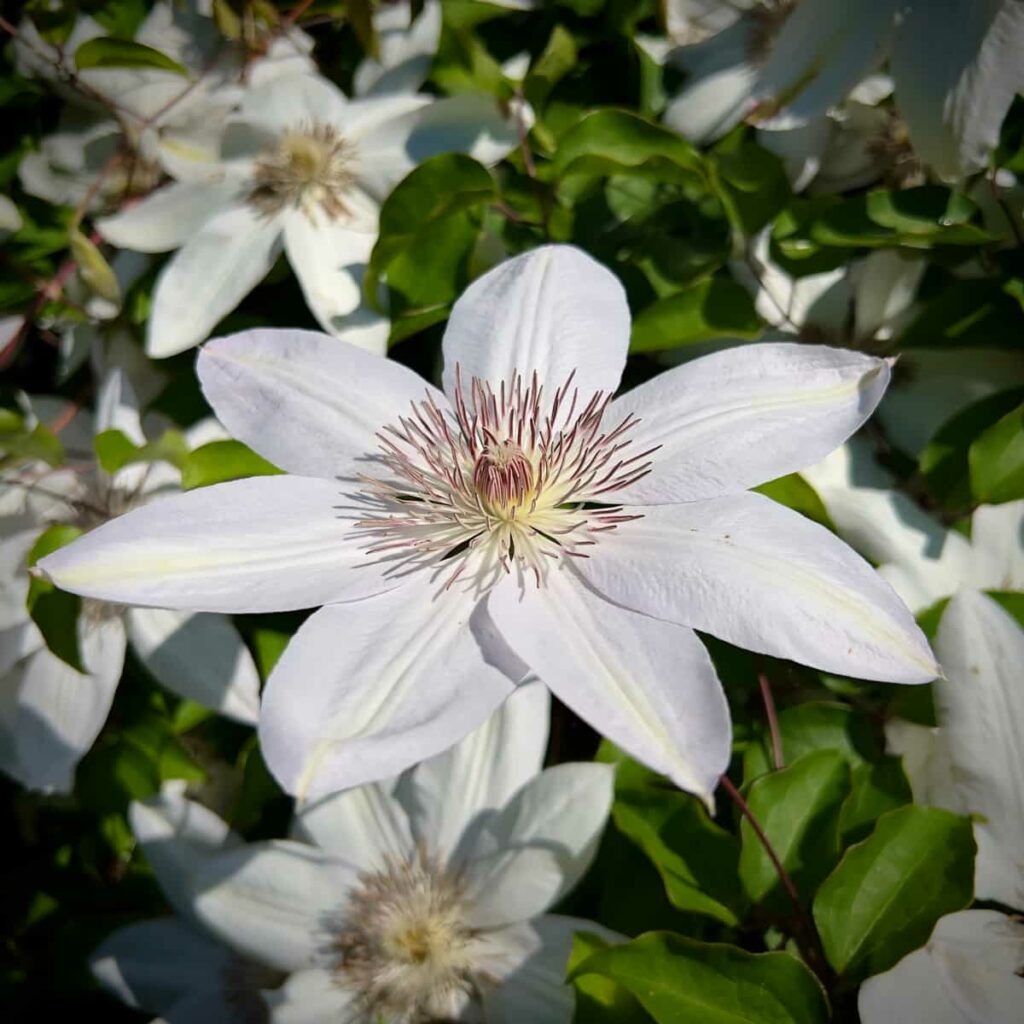
Slow-Release Fertilizers for Clematis
Slow-release fertilizers are an excellent option for feeding your Clematis plants. These fertilizers provide a steady and controlled release of nutrients over an extended period, ensuring that your plants receive a consistent supply of essential elements. One benefit of using slow-release fertilizers is reducing the risk of nutrient leaching. This means that the nutrients are released gradually and are less likely to be washed away by rain or irrigation, which can happen with other types of fertilizer.
With slow-release fertilizers, you don’t have to worry about frequently applying fertilizer to your Clematis plants. Depending on the specific product’s instructions, you can apply these fertilizers once or twice during the growing season. Slow-release fertilizers come in different forms: granules, spikes, or pellets. Granules can be spread around the plant base and watered in, while spikes and pellets can be inserted into the soil near the roots.
These fertilizers typically contain a balanced NPK ratio but may include micronutrients necessary for healthy growth. Always check the packaging for specific nutrient content before purchasing. Slow-release fertilizers offer a convenient and effective way to provide long-lasting nutrition to your Clematis plants without frequent applications.
Liquid Fertilizers for Clematis
These fertilizers are typically concentrated, mixed with water, and then applied to the soil around your plants. Liquid fertilizers are absorbed by the roots of your Clematis, providing them with an immediate boost of nutrients. You can adjust the fertilizer concentration based on your Clematis’ specific needs at different growth stages.
This flexibility allows you to provide targeted nutrition throughout the growing season. Another benefit is that liquid fertilizers often contain balanced essential nutrients like nitrogen, phosphorus, and potassium (NPK). These nutrients support healthy root development, strong stems, vibrant blooms, and plant vigor.
In case you missed it: Best Organic Fertilizers to Feed Plants: DYI for Potted, Backyard, Indoors, and Terrace Garden

Granular Fertilizers for Clematis
These solid, slow-release pellets provide a steady supply of nutrients to the plant over time. Granular fertilizers are convenient and easy to apply, as you sprinkle them around the base of the plant and water them in. One advantage of granular fertilizers is that they release nutrients slowly, which helps prevent over-fertilization and ensures that your Clematis receives a consistent supply of nutrients throughout the growing season. They also tend to have a longer-lasting effect than liquid or organic fertilizers.
Conclusion
Nutritional needs play a vital role in the overall health and vigor of Clematis. These needs encompass macronutrients such as N, P, and K and essential micronutrients like iron, manganese, zinc, and others. By addressing their nutritional requirements with appropriate fertilizers or amendments tailored specifically for Clematis plants’ needs, you can help them reach their full potential in terms of vitality and beauty.
- How to Raise Pigs in Your Own Backyard: A Comprehensive Guide
- Budget Friendly Sheep Shed Ideas: Cheap and Low-Cost Tips
- How Much Do Cattle Farmers Make: Revenue Streams in Cattle Farming
- Management Pests and Diseases in Your Cotton Field
- Sheep Farming Business Plan for Beginners
- Aquaponic Farming at Home: A Step-By-Step Guide
- Profitable Village Farming Business Ideas in 2024
- High-Yield Aquaculture: Fast-Growing Fish for Farming
- Effective Fish Pond Construction Techniques for Beginners
- Irrigation and Water Management in Pineapple Farming
- Blossom to Harvest: Mastering Flowering and Pollination in Papaya Farming
- Pig Fattening Essentials: From Selection to Sale for Beginners
- Raising Wagyu Cattle: A Complete Guide for Premium Beef Production
- Soil Types and Their Water Holding Capacity
- Optimizing Irrigation Schedules for Coconut Groves for Enhanced Yield
- Espresso Your Garden: Coffee Grounds for Healthier Acid-Loving Plants
- The Best Soil Mix for Snake Plants: How to Mix Your Own Snake Plant Soil
- Green Thumb Success: Expert Tips for Cultivating Greenhouse Beans All Year Round
- Bloom All Year Round: The Ultimate Guide to Indoor Hyacinth Care
- Eco-Friendly Gardening: How to Make Liquid Fertilizer from Kitchen Waste
- Ultimate Guide to Grow Anise in Pots: Explore Seed Propagation to Harvesting
- Guide to Raising Chester White Pigs: Discover Breed Facts to Growth Management
- Mastering the Elegance: The Ultimate Guide to Weeping Cherry Tree Care, Planting, and Maintenance
- Ultimate Guide to Planting Garlic in Grow Bags: Growing Strategies for Beginners
- How to Fix Spider Plant Leaf-Related Problems: Natural and Organic Remedies
- 10 Reasons Why Your Tulsi Plant is Shedding Leaves: Home Remedies and Solutions
- Optimizing Growth and Yield: The Advantages of Palm Bunch Ash Fertilizer
- Utilizing Neem Oil Extract as a Natural Pesticide for Hydrangea
- From Soil to Harvest: Various Ways in Which Farmers Can Use AI Tools
- Steps to Encourage and Induce Citrus Flowers: A Comprehensive Guide
- How to Fix Snake Plant Leaf-Related Issues: Natural and Organic Remedies
- Transform Your Garden into a Fragrant Oasis with Raat Ki Rani (Night Blooming Jasmine)
- Discover the Ideal Chicken Breeds for Philippine Farms
- How to Create a Poultry Egg Farm Business Plan for Profits
- Grow Lemon Cucumbers Like a Pro: Insider Techniques for Bountiful Yields
- Ultimate Guide to Caring for Your Pink Princess Philodendron: Tips for Thriving Variegation
